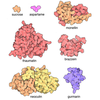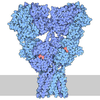+ Open data
Open data
- Basic information
Basic information
| Entry |  | |||||||||
|---|---|---|---|---|---|---|---|---|---|---|
| Title | Structure of the sweet receptor in the apo state | |||||||||
 Map data Map data | Structure of the sweet receptor in the apo state | |||||||||
 Sample Sample |
| |||||||||
 Keywords Keywords | Membrane protein / GPCR / apo state / SIGNALING PROTEIN | |||||||||
| Function / homology |  Function and homology information Function and homology informationClass C/3 (Metabotropic glutamate/pheromone receptors) / Sensory perception of sweet, bitter, and umami (glutamate) taste / sweet taste receptor complex / detection of chemical stimulus involved in sensory perception of sweet taste / sweet taste receptor activity / taste receptor activity / sensory perception of umami taste / G alpha (i) signalling events / sensory perception of sweet taste / Class C/3 (Metabotropic glutamate/pheromone receptors) ...Class C/3 (Metabotropic glutamate/pheromone receptors) / Sensory perception of sweet, bitter, and umami (glutamate) taste / sweet taste receptor complex / detection of chemical stimulus involved in sensory perception of sweet taste / sweet taste receptor activity / taste receptor activity / sensory perception of umami taste / G alpha (i) signalling events / sensory perception of sweet taste / Class C/3 (Metabotropic glutamate/pheromone receptors) / positive regulation of cytokinesis / G protein-coupled receptor activity / Sensory perception of sweet, bitter, and umami (glutamate) taste / G alpha (i) signalling events / receptor complex / G protein-coupled receptor signaling pathway / Golgi apparatus / membrane / plasma membrane Similarity search - Function | |||||||||
| Biological species |  Homo sapiens (human) / Homo sapiens (human) /  | |||||||||
| Method | single particle reconstruction / cryo EM / Resolution: 3.51 Å | |||||||||
 Authors Authors | Wang H / Chen X / Dai Y / Lee CH | |||||||||
| Funding support |  United States, 1 items United States, 1 items
| |||||||||
 Citation Citation |  Journal: To Be Published Journal: To Be PublishedTitle: Structure of the sweet receptor in the apo state Authors: Wang H / Chen X / Dai Y / Lee CH | |||||||||
| History |
|
- Structure visualization
Structure visualization
| Supplemental images |
|---|
- Downloads & links
Downloads & links
-EMDB archive
| Map data |  emd_70730.map.gz emd_70730.map.gz | 49.8 MB |  EMDB map data format EMDB map data format | |
|---|---|---|---|---|
| Header (meta data) |  emd-70730-v30.xml emd-70730-v30.xml emd-70730.xml emd-70730.xml | 17 KB 17 KB | Display Display |  EMDB header EMDB header |
| Images |  emd_70730.png emd_70730.png | 45.7 KB | ||
| Filedesc metadata |  emd-70730.cif.gz emd-70730.cif.gz | 6.4 KB | ||
| Others |  emd_70730_half_map_1.map.gz emd_70730_half_map_1.map.gz emd_70730_half_map_2.map.gz emd_70730_half_map_2.map.gz | 49 MB 49 MB | ||
| Archive directory |  http://ftp.pdbj.org/pub/emdb/structures/EMD-70730 http://ftp.pdbj.org/pub/emdb/structures/EMD-70730 ftp://ftp.pdbj.org/pub/emdb/structures/EMD-70730 ftp://ftp.pdbj.org/pub/emdb/structures/EMD-70730 | HTTPS FTP |
-Validation report
| Summary document |  emd_70730_validation.pdf.gz emd_70730_validation.pdf.gz | 808 KB | Display |  EMDB validaton report EMDB validaton report |
|---|---|---|---|---|
| Full document |  emd_70730_full_validation.pdf.gz emd_70730_full_validation.pdf.gz | 807.6 KB | Display | |
| Data in XML |  emd_70730_validation.xml.gz emd_70730_validation.xml.gz | 12 KB | Display | |
| Data in CIF |  emd_70730_validation.cif.gz emd_70730_validation.cif.gz | 14.2 KB | Display | |
| Arichive directory |  https://ftp.pdbj.org/pub/emdb/validation_reports/EMD-70730 https://ftp.pdbj.org/pub/emdb/validation_reports/EMD-70730 ftp://ftp.pdbj.org/pub/emdb/validation_reports/EMD-70730 ftp://ftp.pdbj.org/pub/emdb/validation_reports/EMD-70730 | HTTPS FTP |
-Related structure data
| Related structure data |  9opyMC M: atomic model generated by this map C: citing same article ( |
|---|---|
| Similar structure data | Similarity search - Function & homology  F&H Search F&H Search |
- Links
Links
| EMDB pages |  EMDB (EBI/PDBe) / EMDB (EBI/PDBe) /  EMDataResource EMDataResource |
|---|---|
| Related items in Molecule of the Month |
- Map
Map
| File |  Download / File: emd_70730.map.gz / Format: CCP4 / Size: 52.7 MB / Type: IMAGE STORED AS FLOATING POINT NUMBER (4 BYTES) Download / File: emd_70730.map.gz / Format: CCP4 / Size: 52.7 MB / Type: IMAGE STORED AS FLOATING POINT NUMBER (4 BYTES) | ||||||||||||||||||||||||||||||||||||
|---|---|---|---|---|---|---|---|---|---|---|---|---|---|---|---|---|---|---|---|---|---|---|---|---|---|---|---|---|---|---|---|---|---|---|---|---|---|
| Annotation | Structure of the sweet receptor in the apo state | ||||||||||||||||||||||||||||||||||||
| Projections & slices | Image control
Images are generated by Spider. | ||||||||||||||||||||||||||||||||||||
| Voxel size | X=Y=Z: 1.298 Å | ||||||||||||||||||||||||||||||||||||
| Density |
| ||||||||||||||||||||||||||||||||||||
| Symmetry | Space group: 1 | ||||||||||||||||||||||||||||||||||||
| Details | EMDB XML:
|
-Supplemental data
-Half map: Half Map B
| File | emd_70730_half_map_1.map | ||||||||||||
|---|---|---|---|---|---|---|---|---|---|---|---|---|---|
| Annotation | Half Map B | ||||||||||||
| Projections & Slices |
| ||||||||||||
| Density Histograms |
-Half map: Half Map A
| File | emd_70730_half_map_2.map | ||||||||||||
|---|---|---|---|---|---|---|---|---|---|---|---|---|---|
| Annotation | Half Map A | ||||||||||||
| Projections & Slices |
| ||||||||||||
| Density Histograms |
- Sample components
Sample components
-Entire : Human TAS1R2 and mouse TAS1R3 sweet receptor in the apo state
| Entire | Name: Human TAS1R2 and mouse TAS1R3 sweet receptor in the apo state |
|---|---|
| Components |
|
-Supramolecule #1: Human TAS1R2 and mouse TAS1R3 sweet receptor in the apo state
| Supramolecule | Name: Human TAS1R2 and mouse TAS1R3 sweet receptor in the apo state type: complex / ID: 1 / Parent: 0 / Macromolecule list: all |
|---|---|
| Source (natural) | Organism:  Homo sapiens (human) Homo sapiens (human) |
-Macromolecule #1: Taste receptor type 1 member 2
| Macromolecule | Name: Taste receptor type 1 member 2 / type: protein_or_peptide / ID: 1 / Number of copies: 1 / Enantiomer: LEVO |
|---|---|
| Source (natural) | Organism:  Homo sapiens (human) Homo sapiens (human) |
| Molecular weight | Theoretical: 93.126281 KDa |
| Recombinant expression | Organism:  Homo sapiens (human) Homo sapiens (human) |
| Sequence | String: EPAENSDFYL PGDYLLGGLF SLHANMKGIV HLNFLQVPMC KEYEVKVIGY NLMQAMRFAV EEINNDSSLL PGVLLGYEIV DVCYISNNV QPVLYFLAHE DNLLPIQEDY SNYSSRVVAV IGPDNSESVM TVANFLSLFL LPQITYSAIS DELRDKVRFP A LLRTTPSA ...String: EPAENSDFYL PGDYLLGGLF SLHANMKGIV HLNFLQVPMC KEYEVKVIGY NLMQAMRFAV EEINNDSSLL PGVLLGYEIV DVCYISNNV QPVLYFLAHE DNLLPIQEDY SNYSSRVVAV IGPDNSESVM TVANFLSLFL LPQITYSAIS DELRDKVRFP A LLRTTPSA DHHIEAMVQL MLHFRWNWII VLVSNDTYGR DNGQLLGERV ARRDICIAFQ ETLPTLQPNQ NMTSEERQRL VT IVDKLQQ STARVVVVFS PDLTLYHFFN EVLRQNFTGA VWIASESWAI DPVLHNLTEL RHLGTFLGIT IQSVPIPGFS EFR EWGPQA GPPPLSRTSQ SYTCNQECDN CLNATLSFNT ILRLSGERVV YSVYSAVYAV AHALHSLLGC DKSTCTKRVV YPWQ LLEEI WKVNFTLLDH QIFFDPQGDV ALHLEIVQWQ WDRSQNPFQS VASYYPLQRQ LKNIQDISWH TINNTIPMSM CSKRC QSGQ KKKPVGIHVC CFECIDCLPG TFLNHTEDEY ECQACPNNEW SYQSETSCFK RQLVFLEWHE APTIAVALLA ALGFLS TLA ILVIFWRHFQ TPIVRSAGGP MCFLMLTLLL VAYMVVPVYV GPPKVSTCLC RQALFPLCFT ICISCIAVRS FQIVCAF KM ASRFPRAYSY WVRYQGPYVS MAFITVLKMV IVVIGMLATG LSPTTRTDPD DPKITIVSCN PNYRNSLLFN TSLDLLLS V VGFSFAYMGK ELPTNYNEAK FITLSMTFYF TSSVSLCTFM SAYSGVLVTI VDLLVTVLNL LAISLGYFGP KCYMILFYP ERNTPAYFNS MIQGYTMRRD UniProtKB: Taste receptor type 1 member 2 |
-Macromolecule #2: Taste receptor type 1 member 3
| Macromolecule | Name: Taste receptor type 1 member 3 / type: protein_or_peptide / ID: 2 / Number of copies: 1 / Enantiomer: LEVO |
|---|---|
| Source (natural) | Organism:  |
| Molecular weight | Theoretical: 90.236078 KDa |
| Recombinant expression | Organism:  Homo sapiens (human) Homo sapiens (human) |
| Sequence | String: LCLSQQFKAQ GDYILGGLFP LGSTEEATLN QRTQPNSIPC NRFSPLGLFL AMAMKMAVEE INNGSALLPG LRLGYDLFDT CSEPVVTMK SSLMFLAKVG SQSIAAYCNY TQYQPRVLAV IGPHSSELAL ITGKFFSFFL MPQVSYSASM DRLSDRETFP S FFRTVPSD ...String: LCLSQQFKAQ GDYILGGLFP LGSTEEATLN QRTQPNSIPC NRFSPLGLFL AMAMKMAVEE INNGSALLPG LRLGYDLFDT CSEPVVTMK SSLMFLAKVG SQSIAAYCNY TQYQPRVLAV IGPHSSELAL ITGKFFSFFL MPQVSYSASM DRLSDRETFP S FFRTVPSD RVQLQAVVTL LQNFSWNWVA ALGSDDDYGR EGLSIFSSLA NARGICIAHE GLVPQHDTSG QQLGKVLDVL RQ VNQSKVQ VVVLFASARA VYSLFSYSIH HGLSPKVWVA SESWLTSDLV MTLPNIARVG TVLGFLQRGA LLPEFSHYVE THL ALAADP AFCASLNAEL DLEEHVMGQR CPRCDDIMLQ NLSSGLLQNL SAGQLHHQIF ATYAAVYSVA QALHNTLQCN VSHC HVSEH VLPWQLLENM YNMSFHARDL TLQFDAEGNV DMEYDLKMWV WQSPTPVLHT VGTFNGTLQL QQSKMYWPGN QVPVS QCSR QCKDGQVRRV KGFHSCCYDC VDCKAGSYRK HPDDFTCTPC NQDQWSPEKS TACLPRRPKF LAWGEPVVLS LLLLLC LVL GLALAALGLS VHHWDSPLVQ ASGGSQFCFG LICLGLFCLS VLLFPGRPSS ASCLAQQPMA HLPLTGCLST LFLQAAE TF VESELPLSWA NWLCSYLRGL WAWLVVLLAT FVEAALCAWY LIAFPPEVVT DWSVLPTEVL EHCHVRSWVS LGLVHITN A MLAFLCFLGT FLVQSQPGRY NRARGLTFAM LAYFITWVSF VPLLANVQVA YQPAVQMGAI LVCALGILVT FHLPKCYVL LWLPKLNTQE FFL UniProtKB: Taste receptor type 1 member 3 |
-Experimental details
-Structure determination
| Method | cryo EM |
|---|---|
 Processing Processing | single particle reconstruction |
| Aggregation state | particle |
- Sample preparation
Sample preparation
| Buffer | pH: 7 |
|---|---|
| Vitrification | Cryogen name: ETHANE |
- Electron microscopy
Electron microscopy
| Microscope | TFS KRIOS |
|---|---|
| Image recording | Film or detector model: GATAN K3 (6k x 4k) / Average electron dose: 60.6 e/Å2 |
| Electron beam | Acceleration voltage: 300 kV / Electron source:  FIELD EMISSION GUN FIELD EMISSION GUN |
| Electron optics | Illumination mode: OTHER / Imaging mode: BRIGHT FIELD / Cs: 2.7 mm / Nominal defocus max: 2.1 µm / Nominal defocus min: 1.1 µm |
| Experimental equipment |  Model: Titan Krios / Image courtesy: FEI Company |
 Movie
Movie Controller
Controller









 Z (Sec.)
Z (Sec.) Y (Row.)
Y (Row.) X (Col.)
X (Col.)




































